Introduction
Reproduction is a fundamental life process that ensures the continuity of species. All living organisms, whether single-celled or complex multicellular organisms, reproduce to give rise to new individuals. Reproduction not only helps maintain the population but also introduces variations that can be crucial for the survival of species in a changing environment.
Importance of Reproduction
Reproduction serves the following purposes:
- Perpetuation of the Species: Ensures the survival of species over generations.
- Transfer of Genetic Information: DNA, which contains genetic information, is passed on to offspring during reproduction.
- Variation and Evolution: In sexual reproduction, combining genes from two parents introduces variation, which drives evolution.
Asexual Reproduction
Asexual reproduction is a mode of reproduction where a single parent gives rise to offspring without the fusion of gametes. As a result, the offspring produced are genetically identical to the parent, known as clones. This process is common in unicellular organisms and some multicellular organisms.
Characteristics of Asexual Reproduction:
- Involves only one parent.
- Offspring are genetically identical to the parent.
- It is a faster process and requires less energy.
- There is no genetic variation among offspring, which can be a disadvantage in changing environmental conditions.
Types of Asexual Reproduction:
- Binary Fission:
- Process: In binary fission, the parent organism divides into two equal halves, each containing a complete set of DNA identical to the parent.
- Examples: Bacteria, Amoeba, Paramecium.
- Detailed Example: In Amoeba, the nucleus first divides by mitosis, followed by the division of the cytoplasm (cytokinesis), resulting in two identical daughter cells.
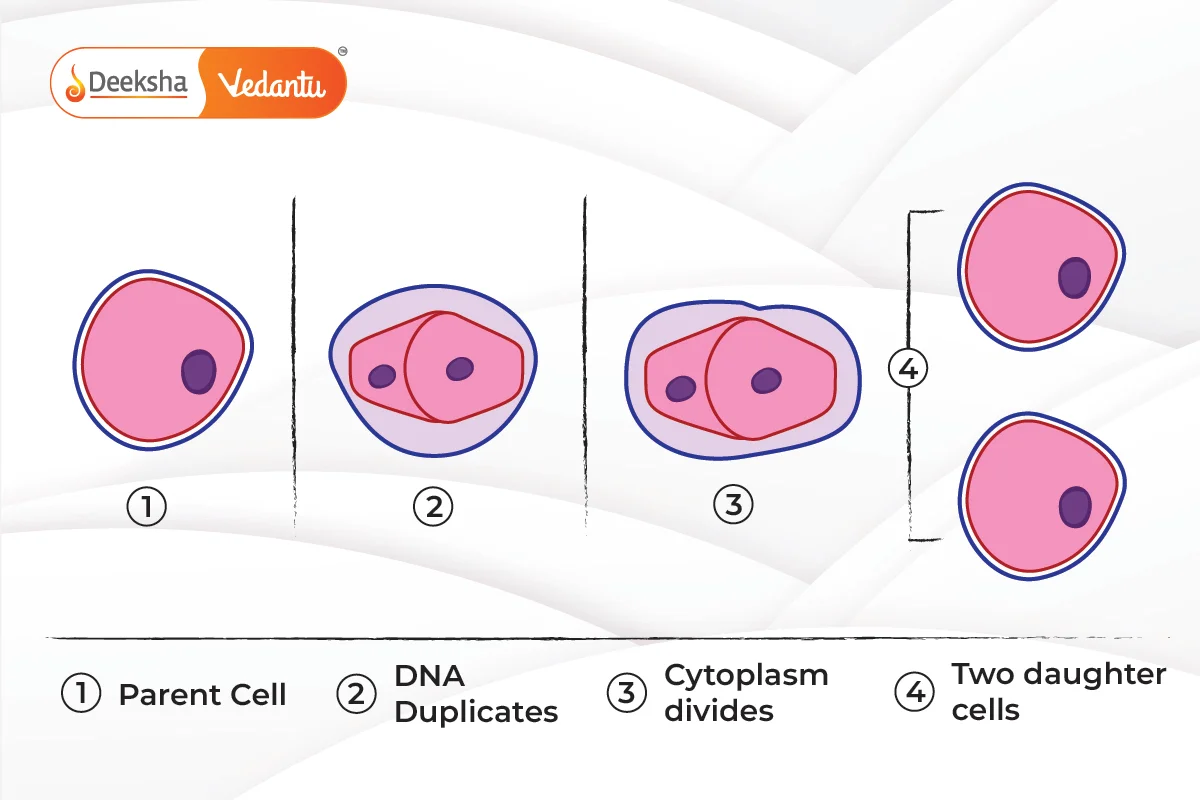
- Multiple Fission:
- In some organisms like Plasmodium (the malaria parasite), the parent cell divides into many daughter cells simultaneously, producing multiple offspring.
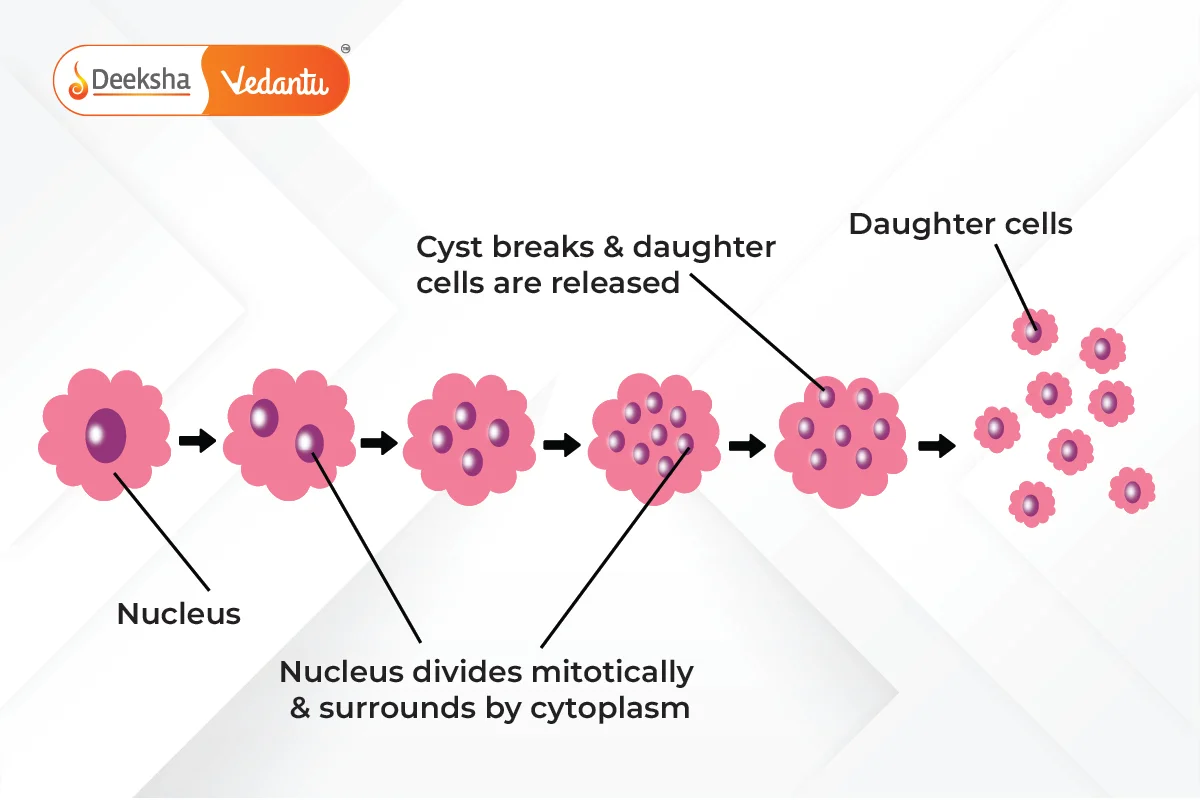
- Fragmentation:
- Process: The organism’s body breaks into two or more fragments, and each fragment grows into a complete organism.
- Examples: Spirogyra, Planaria.
- Detailed Example: In Spirogyra, an algae filament breaks into smaller fragments, each capable of growing into a full filament through cell division.
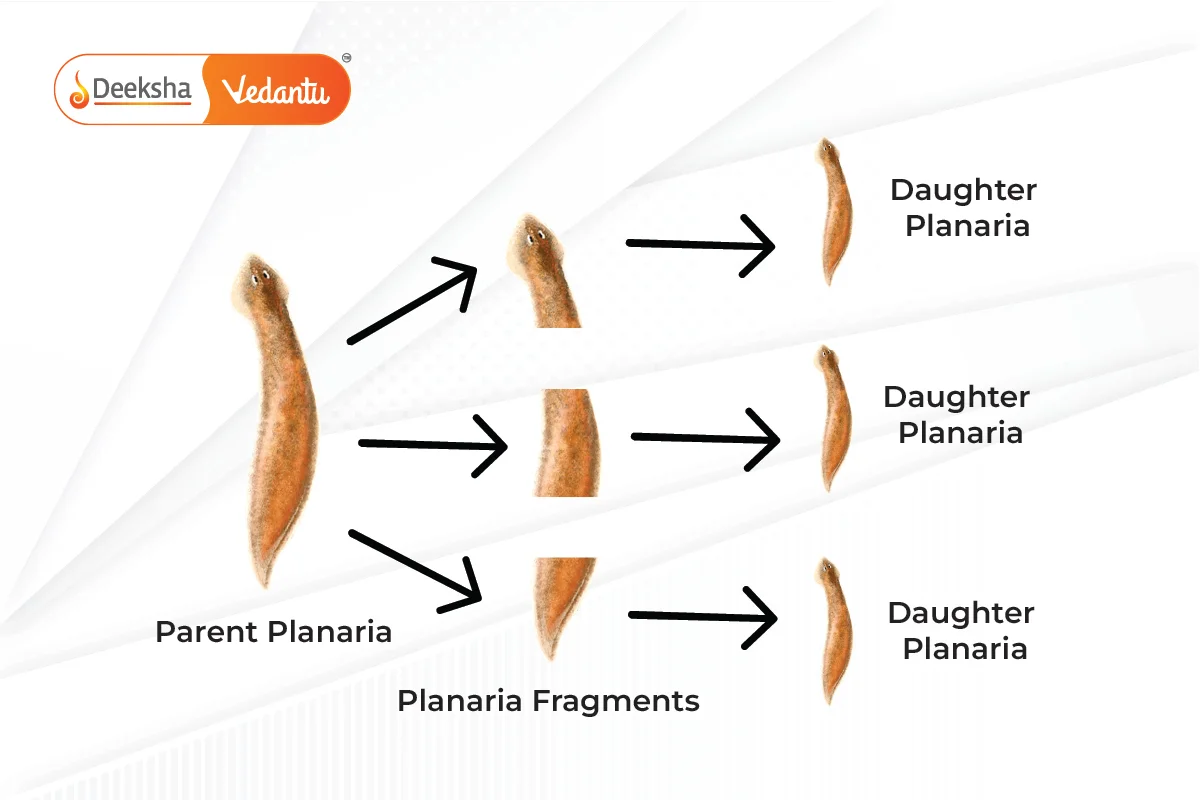
- Budding:
- Process: A new organism develops as an outgrowth or bud on the parent organism. The bud eventually detaches and becomes a new individual.
- Examples: Hydra, Yeast.
- Detailed Example: In Hydra, small buds appear on the parent body. These buds gradually develop tentacles and mouth, and eventually detach to live independently.
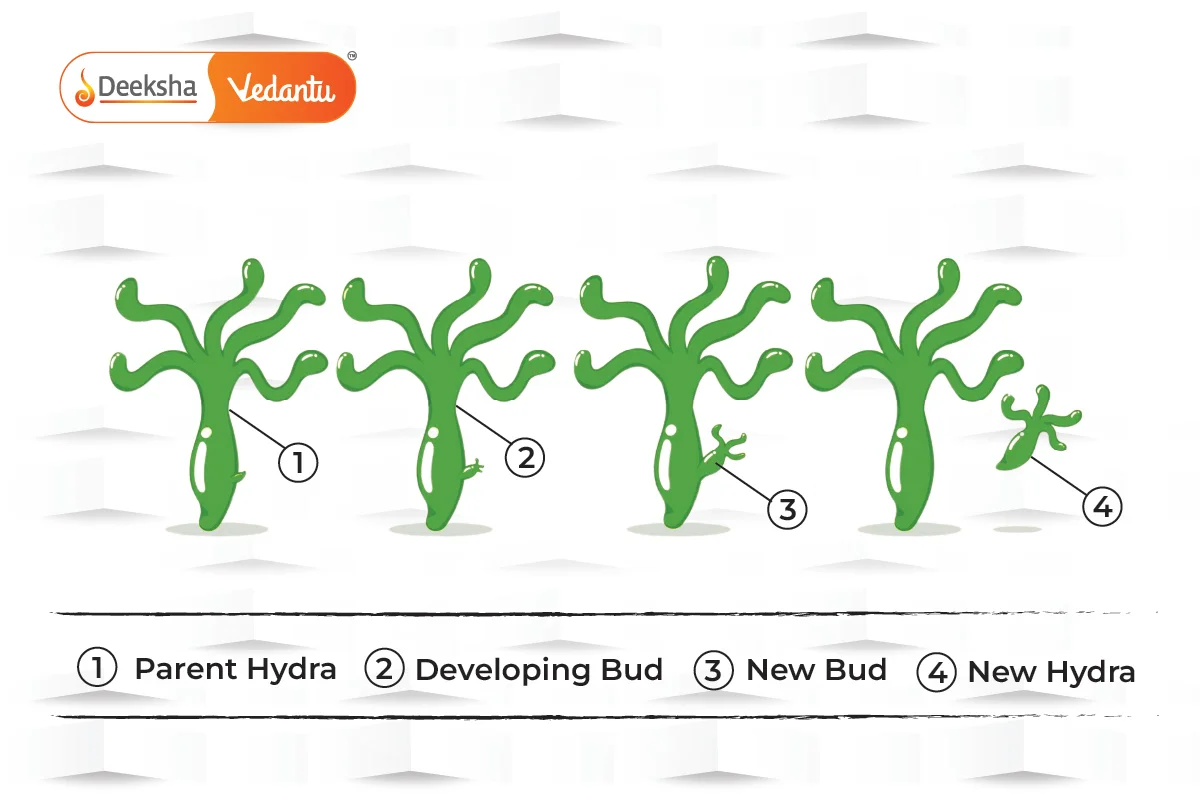
- Spore Formation:
- Process: Spores are produced by the parent organism in specialized structures called sporangia. When conditions become favorable, spores germinate to form new individuals.
- Examples: Rhizopus (bread mold), Fungi, Ferns.
- Detailed Example: In Rhizopus, spores are produced in sporangia and released when the sporangium bursts open. Under favorable conditions, spores germinate to form new fungal hyphae.

- Vegetative Propagation:
- Process: A form of asexual reproduction in plants where new plants arise from vegetative parts like roots, stems, or leaves.
- Examples: Potato (tuber), Bryophyllum (leaf), Ginger (rhizome).
- Detailed Example: In Bryophyllum, tiny buds (called adventitious buds) grow on the edges of the leaves. When the leaf falls to the ground, these buds develop into new plants.
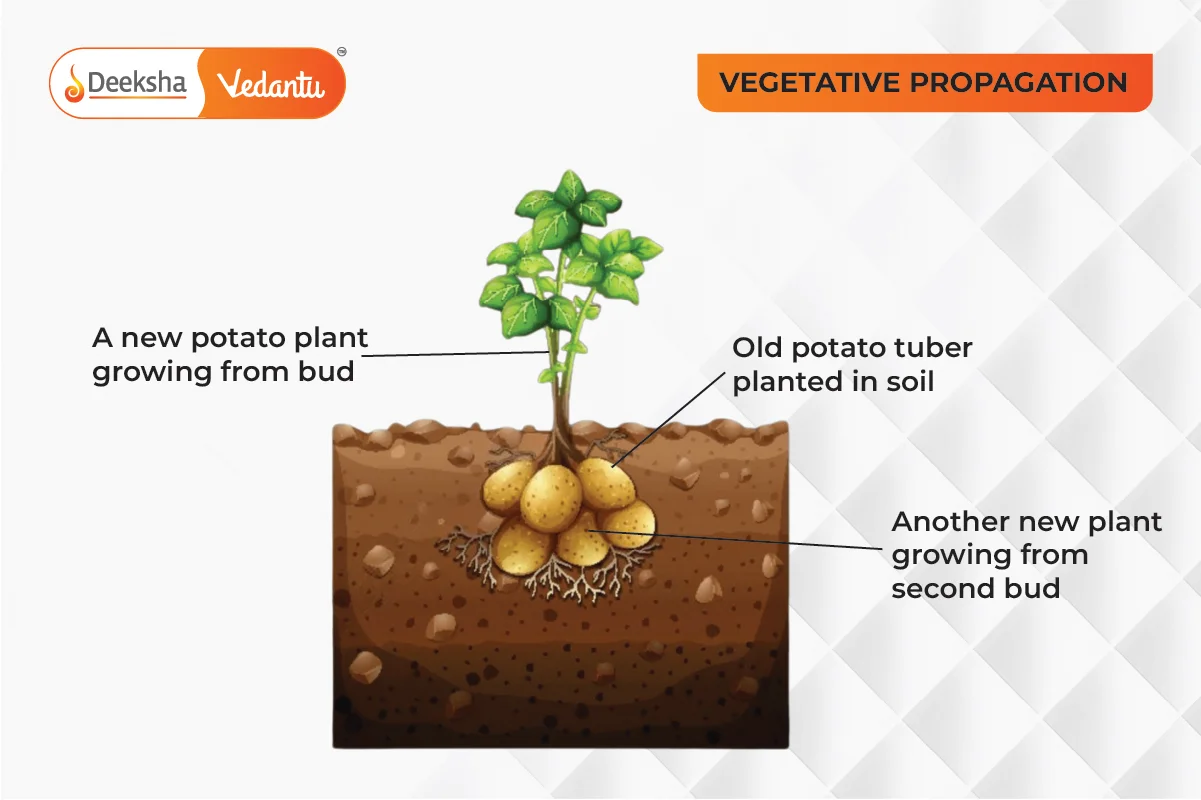
Advantages of Asexual Reproduction:
- Rapid population growth.
- No need for a mate.
- Useful in stable environments where the genetic variation is not as crucial.
Disadvantages:
- Lack of genetic variation.
- Lower adaptability to environmental changes.
Sexual Reproduction
Sexual reproduction is a mode of reproduction that involves the fusion of male and female gametes, resulting in offspring that are genetically different from the parents. This introduces variation, which is crucial for evolution and adaptation to changing environments.
Characteristics of Sexual Reproduction:
- Involves two parents (male and female).
- Offspring are genetically diverse.
- Fusion of male and female gametes results in variation in the offspring.
DNA and Variation in Sexual Reproduction:
- DNA copying is the fundamental process during reproduction, ensuring that the genetic information is passed on to the offspring.
- During sexual reproduction, meiosis (a type of cell division) ensures that the gametes contain half the number of chromosomes (haploid). After fertilization, the zygote restores the diploid number of chromosomes.
- Variation arises from the mixing of genes from two parents, leading to offspring with unique genetic combinations.
Sexual Reproduction in Plants
In flowering plants, sexual reproduction involves the production of male and female gametes, which fuse during fertilization to form seeds.
Parts of a Flower:
- Stamen (Male Reproductive Part):
- Anther: Produces pollen grains, which contain the male gametes.
- Filament: Supports the anther.
- Pistil (Female Reproductive Part):
- Stigma: The sticky surface that receives pollen grains.
- Style: Connects the stigma to the ovary.
- Ovary: Contains ovules, where the female gamete (egg) is located.
Pollination:
- Pollination is the process of transferring pollen from the anther to the stigma of a flower.
- Self-pollination: Pollen from the same flower or a different flower on the same plant lands on the stigma.
- Cross-pollination: Pollen is transferred from the anther of one plant to the stigma of a different plant. This process is often facilitated by agents like wind, water, or insects.

Fertilization:
- After pollination, the pollen grain germinates on the stigma and grows a pollen tube down the style toward the ovary. The male gamete travels down the pollen tube and fuses with the female gamete in the ovule to form a zygote.
- The zygote develops into an embryo, and the ovule matures into a seed, while the ovary develops into a fruit.
Sexual Reproduction in Human Beings
Humans reproduce sexually, involving the fusion of male and female gametes.
Male Reproductive System:
- Testes: Produce sperm (male gametes) and testosterone, a hormone responsible for male secondary sexual characteristics.
- Vas Deferens: A duct that transports sperm from the testes to the urethra.
- Urethra: A common duct for urine and semen.
- Penis: The organ that delivers sperm into the female reproductive tract during sexual intercourse.
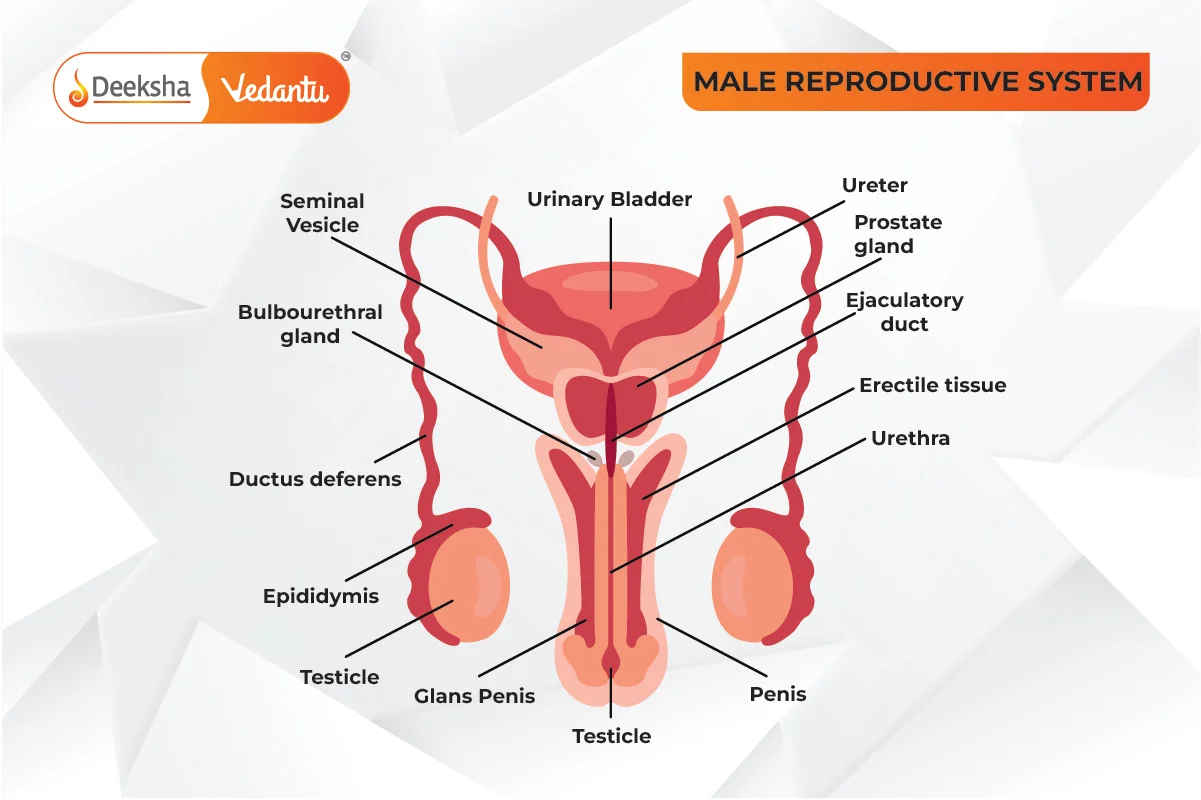
Female Reproductive System:
- Ovaries: Produce eggs (ova) and hormones (estrogen and progesterone) that regulate the menstrual cycle and pregnancy.
- Fallopian Tubes (Oviducts): Transport the egg from the ovary to the uterus. Fertilization usually occurs here.
- Uterus: A muscular organ where the fertilized egg (zygote) implants and develops into a fetus.
- Vagina: The passage through which the baby is delivered during birth and where sperm is deposited during sexual intercourse.
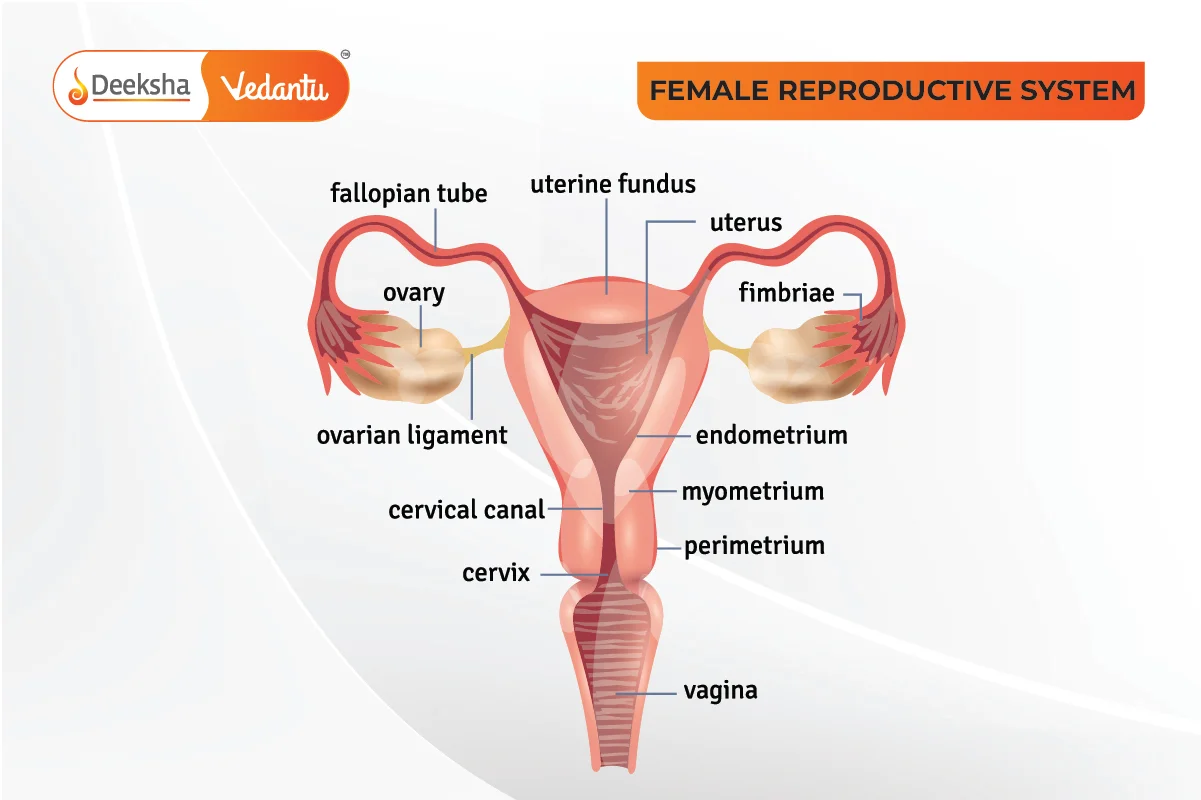
Fertilization:
- During sexual intercourse, sperm are ejaculated into the female’s vagina. The sperm swim through the uterus to reach the fallopian tubes, where fertilization occurs.
- The fusion of the sperm and egg forms a zygote, which undergoes multiple cell divisions to form an embryo.
- The embryo implants in the uterus and develops into a fetus.
Menstrual Cycle
The menstrual cycle is a regular cycle that prepares the female body for pregnancy. If fertilization does not occur, the uterus lining sheds, resulting in menstruation.
Stages of the Menstrual Cycle:
- Menstrual Phase: The uterus lining sheds if the egg is not fertilized (menstruation).
- Follicular Phase: Follicles in the ovaries mature, and one egg is prepared for ovulation.
- Ovulation: The mature egg is released from the ovary into the fallopian tube.
- Luteal Phase: The uterus lining thickens to prepare for possible implantation. If fertilization does not occur, the cycle repeats.
Reproductive Health and Contraception
Maintaining reproductive health is essential to ensure healthy offspring and prevent the spread of sexually transmitted diseases (STDs).
Methods of Contraception:
- Barrier Methods:
- Prevent sperm from reaching the egg.
- Examples: Condoms, Diaphragms.
- Hormonal Methods:
- Regulate hormones to prevent ovulation.
- Examples: Oral contraceptive pills, Injections, Patches.
- Intrauterine Devices (IUDs):
- Inserted into the uterus to prevent implantation of the fertilized egg.
- Example: Copper-T.
- Surgical Methods:
- Vasectomy: Surgical procedure in males where the vas deferens is cut or sealed.
- Tubectomy: Surgical procedure in females where the fallopian tubes are blocked or cut.
Importance of Reproductive Health:
- Preventing STDs like HIV/AIDS, syphilis, and gonorrhea.
- Family planning and spacing of children.
- Maintaining physical and emotional health.
Practice Questions
Q1: Explain the process of fertilization in humans.
- Answer: Fertilization occurs when the sperm from the male fuses with the egg from the female in the fallopian tube. The sperm penetrates the egg, and the nuclei of both gametes fuse, forming a zygote. This zygote undergoes multiple divisions and eventually implants in the uterus, where it develops into a fetus.
Q2: Describe the process of vegetative propagation with an example.
- Answer: Vegetative propagation is a form of asexual reproduction in plants where new plants grow from vegetative parts like roots, stems, or leaves. For example, potato tubers have buds, known as “eyes,” that sprout and grow into new plants when planted in the soil.
Q3: What are the advantages and disadvantages of asexual reproduction?
- Answer: Asexual reproduction allows for rapid population growth and does not require a mate, making it efficient in stable environments. However, the lack of genetic variation can be a disadvantage in changing environments, as all offspring are genetically identical to the parent.
FAQs
Reproduction ensures the continuation of species by producing new individuals. It also introduces variations that allow organisms to adapt to changes in their environment, enhancing their chances of survival.
DNA copying ensures that genetic information is passed from parent to offspring. Although the copying process is precise, minor errors (mutations) can occur, leading to genetic variation.
Sexual reproduction involves the combination of genes from two parents, leading to genetic diversity among offspring. This variation allows populations to adapt to changing environments and is the basis of evolution.
Related Topics
- Greenhouse Effect
- How Do Our Activities Affect The Environment?
- Excretion
- Human Respiratory System
- Control and Coordination
- Transportation
- Cells
- Cell Organelles
- Mitochondria
- Accumulation Of Variation During Reproduction
- Overview of Food Chain
- Modes Of Reproduction Used By Single Organisms
- Animals – Nervous System
- Nitrogen Cycle
- Mendel’s Laws of Inheritance









Get Social